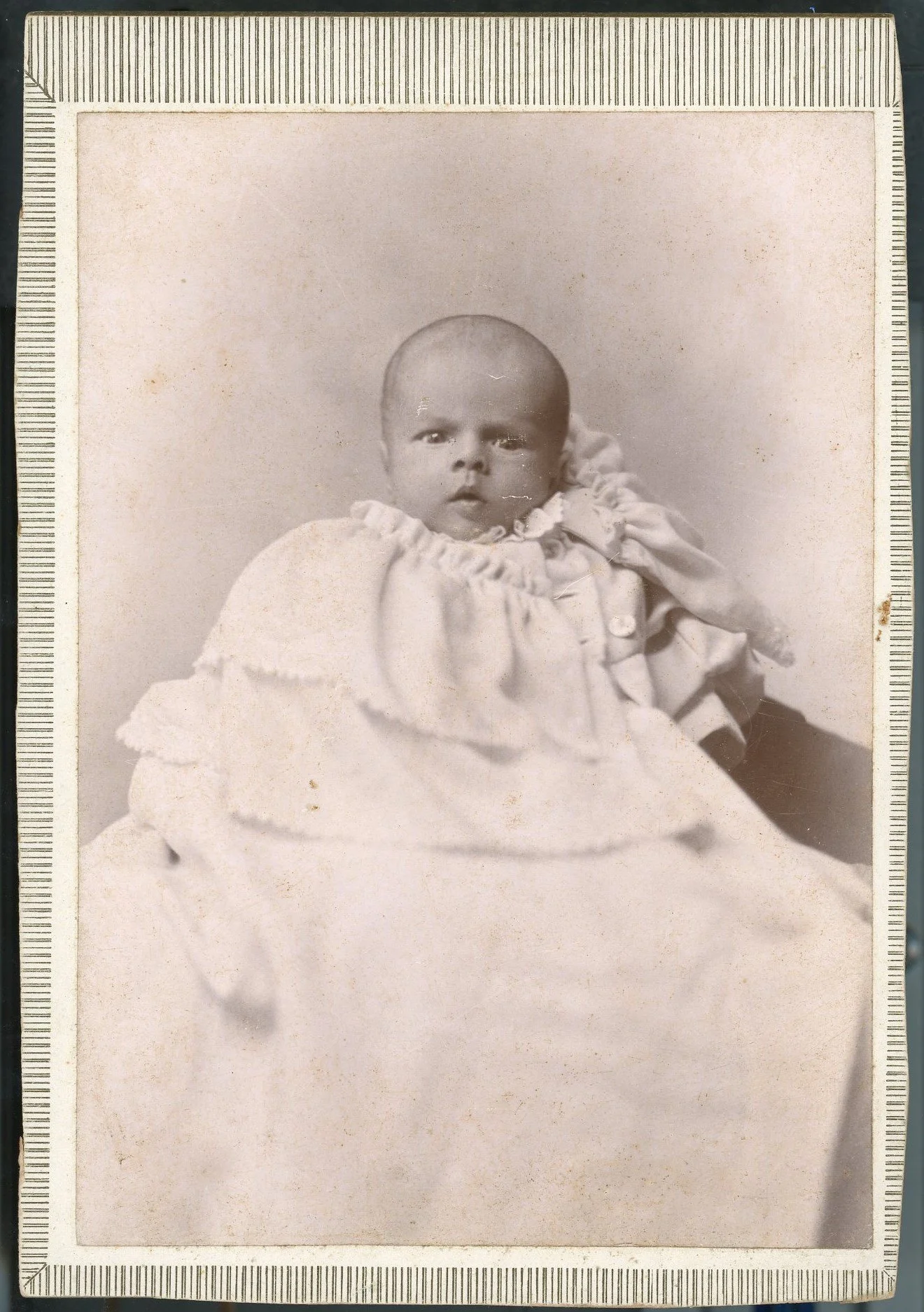“Master Willie Weeks Hall…the Finest Little Boy in the State”
William Weeks Hall as an infant. From the collection of the Shadows-on-the-Teche.
“Lily’s splendid son greets grandpa with his first mornings welcome. He came last night with a lusty yell at 9:20 and mother and son are doing nicely this morning. The little fellow is fat, and very vigorous.”
So the proud father, Gilbert Hall announced the birth of his son William Weeks Hall, in New Orleans, on the night of October 31, 1894. Gilbert was 59-years-old and mother Lily Weeks Hall was 43-years-old when their son was born.
Gilbert obviously doted on Weeks Hall from the moment of his birth. A letter written to his wife in honor of their fifth wedding anniversary on April 22, 1896, pledged his love and went on to praise their “common joy and bond union…our darling little son, the sweetest, cutest, brightest, finest little boy in the state.”
The “finest boy in the state” turned 2-years-old seven months later with a wonderful birthday party described in great detail in the society column of the newspaper. “The grounds were artistically lighted by brilliant Chinese lanterns and behind masses of flowers and twining vines the many colored lights flashed and sparkled.” There was “a very good band” playing “the merriest music” and the children “skipped and danced” about the fairyland-like setting to the amusement of all adults present.
The author closed the column with a blessing for the birthday boy. “May the path of the dear little host be ever strewn with thornless flowers, and may he ever be the sweet all together lovely little King of Hearts that he was [f]or this his first reception.”
In addition to planning wonderful birthday parties, Lily expressed her love and devotion for her only child, her son Weeks Hall, with a poem written at Easter in 1907 in which she addressed the then 12-year-old Weeks Hall as her “noble boy.”
In later years, Weeks Hall remembered excursions to the market with his father when he was a young boy. Apparently, between the time of his birth and age of thirteen, Weeks Hall and his family spent much of the year in the country at the Shadows. “When you are a child in the country, every clear breaking summer day is the creation of the world. Yesterday had not existed. On such days, very early in the morning, after I had my coffee milk, as they call it here, I would occasionally go to the market with my father and I was allowed to carry the empty basket.”
Reflecting on his childhood years, Weeks Hall wrote in 1940 that “[t]here were no other children and it was an adult childhood….” He spoke of long, summer afternoons in the Shadows’ “garret” turning the handle on the even-then old stereopticon, viewing scenes visited by his grandfather and his Aunt Pattie before he was born. He described his “childhood joy” of spending rainy days sitting with the Book of Martyrs, perusing “incredible” woodcuts of “people being drawn and quartered by horses, people being eviscerated, people strung up by their thumbs or by their toes, and all that sort of thing.”
He recorded these memories in 1953, so it is obvious that those “incredible” woodcuts certainly made an impression on the young boy listening to the rain fall on the slate roof overhead.
But in addition to those solitary pursuits, Weeks Hall also remembered favorite playmates, among them Yvonne Arnandez (later Yvonne Patout Southwell). Weeks Hall and Yvonne were quite the performers, singing and dancing, and providing entertainment for family and friends.
Weeks Hall with Gilbert Hall and Lassie. From the collection of the Shadows-on-the-Teche.
When interviewed by Morris Raphael for his book Weeks Hall: Master of the Shadows, Yvonne remembered good times with Weeks Hall, playing with his collie Lassie, exploring the grounds, and setting off down the Bayou Teche “on a old raft.” She recalled the two fearless explorers climbing a crepe myrtle to enter the Shadows through the second-floor window. She also talked about the good times they had pulling the clothes of Weeks Hall’s ancestors from the marvelous treasure trunks on the third floor and playing “dress up.” The adventures were endless.
Weeks Hall displayed his bent for art at an early age, often sketching his young playmate Yvonne as they played in the Shadows’ gardens. Sometime between ages 10 and 13, “Master Willie Weeks Hall” represented New Iberia in the Jeanerette Fair with “a pen and ink drawing of a head in a style particularly distinctive” for which he received a blue ribbon. Some committee members said “the work was really entitled to a gold medal.”
Due to Gilbert’s ill health, the family left the Shadows in December 1907 and moved to Kansas City, Missouri where they lived with relatives until 74-year-old Gilbert died in March 1909. After Gilbert’s death, mother and son moved to New Orleans where they lived with the Zacharie sisters. Weeks Hall attended Julia Street Public High School, from which Weeks Hall wrote “I was never able to graduate.”
Despite his academic difficulties, Weeks Hall showed a definite talent for art. In 1913, Weeks Hall enrolled at the Pennsylvania Academy of the Fine Arts in Philadelphia after receiving scholarships for his art from the New Orleans Art Association. While at the Pennsylvania Academy, Weeks Hall “won the first place European scholarship” to study in Paris and London twice, in both 1915 and 1916. Unfortunately for Weeks Hall, World War I prevented him from taking advantage of the foreign study until 1920-1922.
Originally published in The Weeks Hall Centennial Year pamphlet. The Centennial Year celebration of Weeks Hall’s life ran from October 1993 to October 1994.


